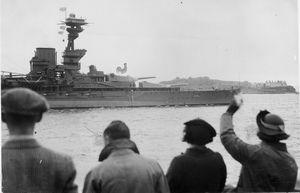Catalogue number 102076
H.M.S. Royal Oak
H.M.S. Royal Oak comes into harbour with the traditional massive wooden Cock on B turret showing off her success in the 1938 regatta. Note the Rear Admiral's ensign flying from the top bridge. Also, note an interesting detail in this photograph, above-water experimental torpedo tubes in recessed ports port and starboard were fitted during the 1934-1936 refit. The torpedo doors starboard can be seen forward at the end of the foredeck scuttles. Parkes, in his monumental book "British Battleships" says that these tubes were not considered of any use in battleships and "all tubes were taken out by 1930". This is in contradiction with what we can see unless the torpedo doors were left in place after removal of the tubes.
Verso:"Cock of the Fleet in port again. Plymouth, Devonshire, England, July 10. H.M.S. Royal Oak, champion sporting ship of the Fleet, with a huge Cock of the Fleet, arrived here, her home port, this evening. It was a proud moment for the giant vessel, and crowds gave her a lusty welcome, as wives and sweethearts waved and cheered. Associated Press photo shows: The Royal Oak arriving at Rusty Anchor, Plymouth, this evening, July 10, the Cock proudly in evidence, while crowds gather to watch the ship approach."
Credit: Associated Press
18cm x 12.5cm Gelatin silver print
|
 |